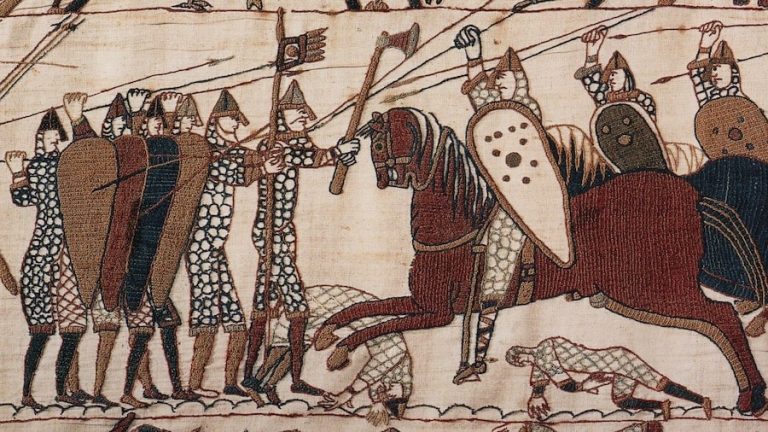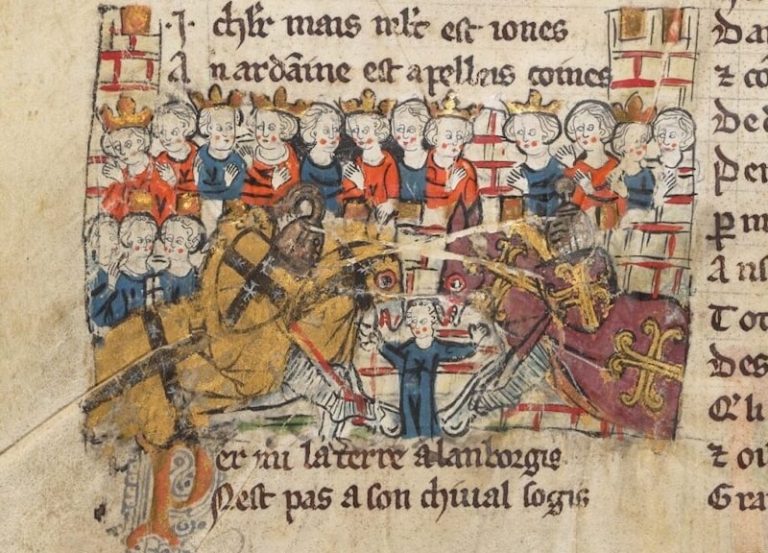Héraldique
Héraldique
Scaricamazza
·1723·
Scaricamazza
·1723·
Why heraldry was born?
Why heraldry was born?
In the last lesson we gave a response, “heraldry was born around 1150”, but we also anticipated questions that we will answer in this article: why heraldry was born?, what are the reasons why it was born precisely around this date? We must report: 1 the identification in battle and armor modifications; 2 the beauty of heraldic art and the role of heraldry in the tournament; 3 the new social order. 1 the identification in battle and armor modifications.
1 The identification in battle and armor modifications. Let’s quote Slater:
«With knights encased in armour, it is clear that armorial devices would have been exceptionally useful, both to their allies and their enemies. A scene in the Bayeux Tapestry records a moment when Duke William was forced to throw back his helmet, exposing his face for instant recognition, even though in 1066 the helmet worn by the European knight stil allowed much of the wearer’s face to be seen. In the mid-12th century the Anglo-Norman poet Robert Wace wrote that at Hastings the Normans “had made cognizances so that one Norman would recognize another, and the Norman French terms connoissances and recognitiones, both of which were used in the 12th century to describe armorial devices, testify to their roles as emblems of recognition. Yet there is an important fact to be remembered when reading Wace’s comment – by his day, a century after Hastings, het well-dressed warrior had started to wear the great helm, which covered all of the face except for the eyes, making identification even more difficult than it would have been at the time of the Norman conquest of England».¹

Bayeux Tapestry, The epic adventure of William the Conqueror in 1066.
2 The beauty of heraldic art and the role of heraldry in the tournament. Let’s quote Fox-Davies:
«However heraldry is looked upon, it must be admitted that from its earliest infancy armory possessed two essential qualities. It was the definite sign of hereditary nobility and rank, and it was practically an integral part of warfare; but also from its earliest infancy it formed a means of decoration. It would be a rash statement to assert that armory has lost its actual military character even now, but it certainly possessed it undiminished so long as tournaments took place, for the armory of the tournament was of a much higher standard than the armory of the battlefield. Armory as an actual part of warfare existed as a means of decoration for the implements of warfare, and as such it certainly continues in some slight degree to the present day».²

Poem of The Tournament of Chauvency – Bodleian Library MS. Douce 308 fol. 113v, Bodleian Libraries, University of Oxford.
The decorative and identifying power of a coat of arms within a tournament certainly played an important role in the birth and development of heraldry. In fact, Slater adds:
«Along the edge of jousting field lay the spectators’ enclosures and the tented encampments of the participants vied with each other in putting on the greatest display of splendor. They would be announced to the crowds by their heralds shouting out their names and titles, and often their arms would be shown to the crowds by men or boys dressed up as monsters, angels, ancient heroes or giants – surely a possibile origin of the heraldic supporters of later days».³
3 The new social order. Finally, as will often happen in the future, the answer, the unexpected point of view, the most correct: Michel Pastoureu’s, obviously.
«However, the origins of heraldry cannot merely be explained in terms of the development of military equipment. The appearance of arms is more deeply rooted in the new social order that took shape in western society in the feudal period. Like the patronymic names that appeared during the same period, or the iconographic attributes that were becoming increasingly common, heraldry gave a new identity to a society that was reorganizing itself. It helped to situate individuals within groups and these groups within the social system as a whole. For that reason, arms, which were originally individual emblems, became hereditary from the end of the 12th century and acquired their definitive form as a result of being passed down through the same family».⁴
¹ Slater, S. (2004). The History and meaning of heraldry. An illustrated reference to classic symbols and their relevance, 1st edn, London: Southwater, p.11.
² Fox-Davies, A.C. (1909). A complete guide to Heraldry, 1st end, London, T.C. & E.C. Jack, p. 24.
³ Slater, S. (2004). The History and meaning of heraldry. An illustrated reference to classic symbols and their relevance, 1st edn, London: Southwater, p.20.
⁴ Pastoureau, M. (1997), Heraldry: its Origins and Meaning, London: Thames & Hudson, pp.19-20.